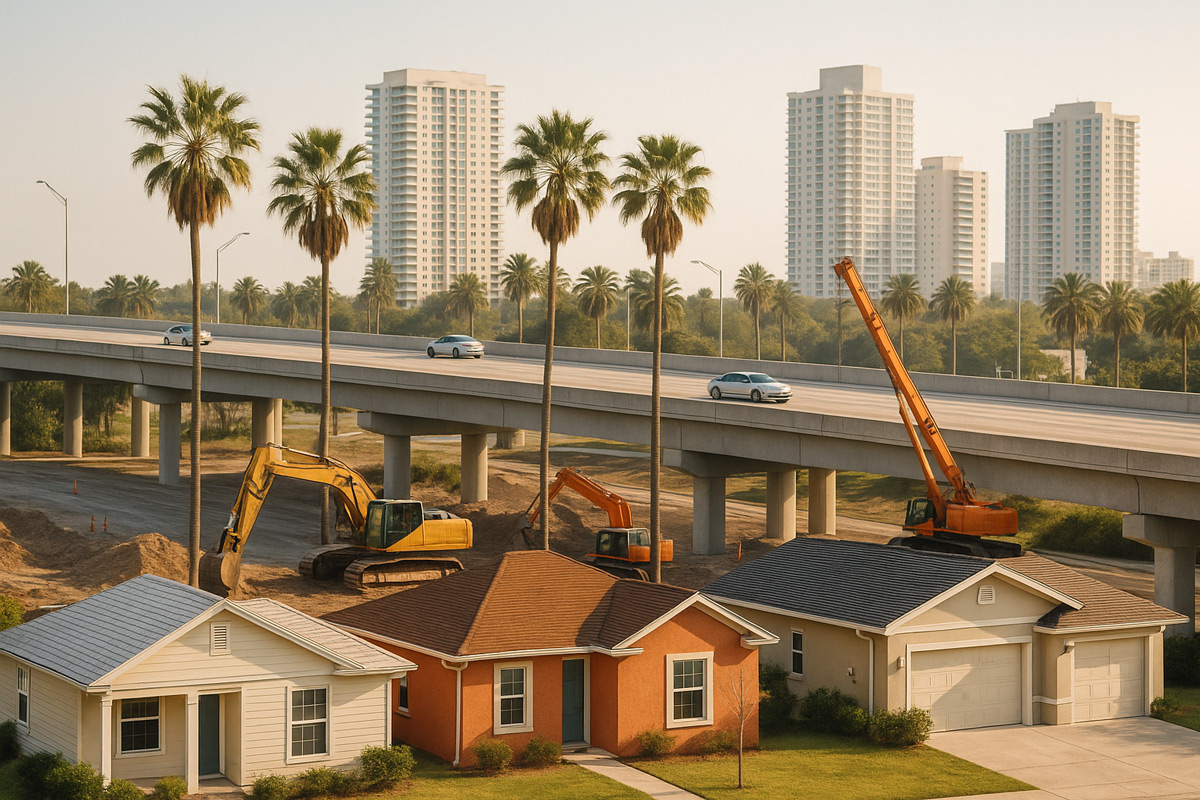
Florida is growing—and fast. With millions flocking to the Sunshine State for its warm climate, favorable tax structure, and booming economy, the demand for housing is skyrocketing. But one key factor is silently steering the shape and scale of this demand: infrastructure development.
Why Infrastructure Projects Matter for Housing
Transportation corridors, rail lines, and even broadband investments don't just move people and data—they also reshape real estate markets. When a new highway or commuter rail line is announced, the land near those projects tends to appreciate quickly. That's because improved access often translates to higher desirability and livability.
According to Florida Times research, the most watched infrastructure developments are between South and Central Florida, where regional connectivity is key to accommodating population growth and economic expansion.
1. Brightline Expansion: Linking Miami and Orlando
High-Speed Rail Meets Real Estate Growth
One of the most transformative projects underway is the Brightline high-speed rail expansion, now connecting Miami, Fort Lauderdale, West Palm Beach, and Orlando. With trains reaching speeds of 125 mph, the trip between Miami and Orlando takes just over three hours.
"This is a game changer for real estate developers," says Jane Doe, a Miami-based real estate analyst. "Properties near Brightline stations are seeing surging investor interest and demand for mixed-use development."
- MiamiCentral Station: Spurring condo and office development in Downtown Miami.
- Aventura & Boca Raton: Residential units are rising within walkable distance to stations.
- Orlando Terminal: Expected to fuel housing demand in Lake Nona and surrounding areas.
Developers are already fast-tracking projects near these nodes, anticipating rental demand from commuters and short-term travelers alike.
2. I-4 Ultimate and Beyond: Reworking Orlando's Highway Core
The I-4 Ultimate project has redefined how Central Florida moves. Spanning 21 miles through Orlando, it includes rebuilt interchanges, express lanes, and improved safety systems.
But what's next? The proposed "I-4 Beyond the Ultimate" aims to extend improvements into Polk and Volusia Counties—areas where housing affordability still exists but requires better connectivity to urban cores.
John Smith, a transportation consultant based in Orlando, explains, "We advise our clients to consider areas just beyond the I-4 corridor, where planned exits and improved access will likely lead to rapid suburban development."
Key Areas to Watch:
- Davenport: Already one of the fastest-growing cities for first-time buyers and retirees.
- DeLand: Historic charm meets modern infrastructure upgrades.
3. Miami-Dade's SMART Plan: Local Transit, Big Impact
While high-speed rail gets headlines, local transit is equally crucial. The SMART Plan (Strategic Miami Area Rapid Transit) aims to expand bus rapid transit and rail service in six major corridors throughout Miami-Dade County.
Most notably, the South Dade TransitWay is already under construction and set to become a Bus Rapid Transit (BRT) corridor serving communities between Kendall and Florida City. As travel times shorten, developers are focusing on infill development and transit-oriented housing along the route.
This includes affordable housing initiatives coordinated with the Miami-Dade County Department of Public Housing and Community Development to ensure equitable growth.
4. Broadband and Utilities: The Silent Infrastructure Drivers
Not all infrastructure is visible. Florida's push for universal broadband access in underserved areas—especially in parts of Osceola, Sumter, and Flagler counties—is opening up new frontiers for remote workers and tech-driven buyers.
Additionally, major upgrades to water and sewer systems in suburban pockets across Hillsborough and Pasco Counties are allowing for higher-density zoning and new permitting for multifamily housing.
Pro tip: Homebuyers should look beyond roads and rails—utility infrastructure is a leading indicator of where new residential growth will emerge.
5. Airport Expansions: Tourism Meets Local Growth
Florida's airports are also expanding rapidly. Orlando International Airport (MCO) has opened Terminal C, capable of serving 10-12 million additional passengers annually. Meanwhile, Miami International Airport (MIA) and Tampa International (TPA) are undergoing multibillion-dollar expansions.
These upgrades have a direct impact on nearby housing markets. Areas like Lake Nona (Orlando) and Westchester (Miami-Dade) are seeing rising demand for both short-term rentals and permanent housing.
Practical Advice for Buyers and Investors
- Study infrastructure maps released by county planning departments and state DOT.
- Monitor rezoning requests and building permits near major infrastructure projects.
- Act early: Pre-construction phases offer the best pricing and appreciation potential.
- Consult with local real estate experts who understand hyper-local zoning and transit effects.
Whether you're a homeowner looking for long-term appreciation or an investor eyeing the next growth corridor, aligning with Florida's infrastructure blueprint is essential.
Looking Ahead
Florida's infrastructure investments are no longer just transportation upgrades—they're economic blueprints reshaping entire communities. As the state builds smarter and faster, real estate opportunities will increasingly follow the tracks, roads, and wires.
For more insights like these on how Florida's housing market is evolving, subscribe to our weekly newsletter and stay one step ahead of the curve.